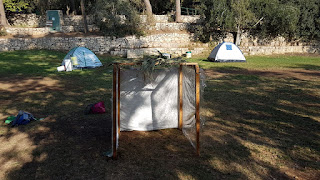The Frame
 |
| The Frame |
There are many guides for DIY sukkah construction using PVC pipes. The problem with this is that PVC pipes are less popular in Israel than in the US, so I found that I was very limited in terms of what I could buy.
On the other hand, the town where I live has hundreds of piles of agricultural waste and scrap wood, so I decided to see what scrap-wood I could find. After a few minutes of visiting the piles on my street I hit the jackpot: someone had thrown out a heavy wood Sukka wall with a bit of water damage. I brought it home, took it apart and soon had four posts and two interlocking beams. I salvaged some wood from my attic for another two beams and had a frame about 1 meter-cubed. I added some screws so that the beams could easily be locked together with heavy zip-ties upon reaching the campground.
The Walls
On a practical note, I'll just point out that the cheaper plastic tablecloth was stronger. The nicer, softer tablecloth had a tendency to tear where it was stapled to the posts, especially when a kid would lean against a wall. This problem wasn't terrible, but I did have to re-staple walls a couple of times, so pick your wall material carefully.
The Schach
 |
| Our Succah Fully Assembled |
How to Schach?
A couple family members declared that to use palm fronds for schach, one must manually separate the individual leaves from one another. I had never heard of this, but I was worried that, after a few days in the sun, the individual leaves would droop into the succah, thus violating the prohibition of Dira Srucha. The Halacha states that schach whose tips hang under 10 Tfachim invalidates the succah.היתה גבוהה מעשרה והוצין יורדין לתוך עשרה אפילו אם חמתן מרובה מצלתן פסולה(או"ח תרלג:ט)
I later asked for a clarification of this practice of separating the palm fronds and was given two possible answers:
- The Minhag of making sure one can see the stars through the schach(Yerushalmi, Succah 2:3)
- The rabbinic prohibition from using boards wider than 4 tfachim(Succah 14A)
Regarding the latter, the shulchan aruch repeates the gemara's language of "boards". Since palm leaves are not boards, nor do they look like a roof, the gzeira shouldn't apply. Here is a psak along those lines.
















